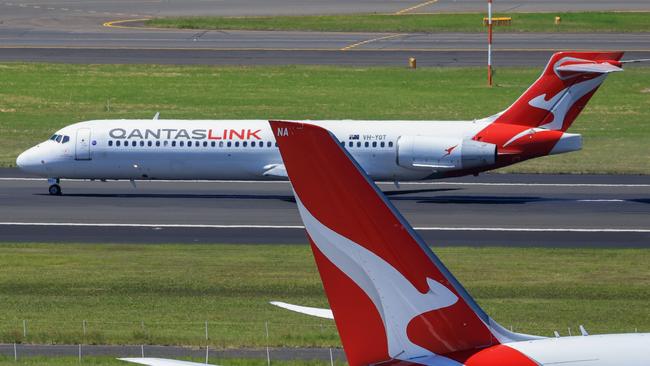
Sydney Airport has just revealed its pre-tax and depreciation earnings more than doubled to a record $1.2bn. A big chunk of its money coming from airline passengers who pay a fee on every airline ticket that uses the nation’s largest airport.
All the while, the airport is in simmering disputes with Qantas, Virgin Australia, Rex and others over landing fees because, as former competition watchdog boss Graeme Samuel – who now chairs an airline lobby group – points out, “they can’t land their planes on the highway”.
Over the trench, Auckland Airport has the airlines up in arms over what Qantas head of domestic and international Cam Wallace describes as “building the Taj Mahal and then expecting Kiwis to pay many times more for the privilege to travel through there”.
The so-called Taj Mahal that Wallace was referring to is the $NZ7bn-$NZ8bn that Auckland Airport, which is traded on the Australian and New Zealand stock exchanges, is planning to spend to better integrate its domestic terminal with the international terminal and increase its capacity by 26 per cent.
In Australia, there is currently about $10bn of proposed works at airports in Australia, with the airlines describing much of it on background as “gold plated infrastructure,” paid for by an unaware public.
Unaware, because many airline passengers don’t realise that airport fees can make up a sometimes sizable chunk of their airfares.
What’s at stake in these battles between airlines and airports – both here and across the world – is access to critical monopoly assets which have been privatised by governments, often with zero or minimal pricing regulations.
Airport charges are airlines’ second largest cost after fuel and play a major role in determining the commercial viability of routes – including regional links. Every increase is therefore met with complaints.
But the airport owners argue they need to charge these fees to fund infrastructure works that frequently run into billions of dollars.
It’s estimated Perth airport, which has been in court with Qantas for years, has $2.5bn of spend planned by 2029, Adelaide has $100m until next year, Melbourne has $3bn-plus by 2028, Brisbane has $3.5bn by 2032, and Sydney has $400m until 2026.
At issue is who is keeping watch on these monopoly infrastructure providers – what they are building and who does it serve – and what is an appropriate return.
Air New Zealand says the cost of the Auckland works will make the price of flying prohibitive for many people, with it estimating the charge for domestic passengers will increase from $9 now to $46 in 2032 to pay for the works.
This, say the airlines, will put the future of domestic travel in jeopardy because of the increased cost of flying.
“It’s not just the big gorillas,” that this will impact says Air New Zealand chief financial officer Richard Thompson. “It’s the smaller airlines too.”
Thompson says Auckland Airport fees could amount to about a quarter of the expense of buying a domestic airline ticket if it’s allowed to proceed with its expansion project.
“The airport can just go and spend this money and is answerable to no one,” says Thompson. “We’ve asked the commerce commission to launch an inquiry urgently. If we get beyond July we get closer and closer to the point of no return… the build is supposed to start in August. There will be serious money starting to get poured into the ground.”
Pre-Covid the Auckland project was set to cost in the order of NZ$4bn but has now doubled. The airlines agree that work needs to be done, and acknowledge that inflation has skyrocketed since then, but say the airport is not doing enough to rein in costs.
Air NZ put forward a proposal that was $1bn to Auckland Airport which was $1bn cheaper to build and it’s understood Qantas managed to come up with a plan that was $2bn less, but the Airport says those plans were “not viable”.
It’s not surprising that the airlines are angry about paying increased fees but the question is whether this is just the cost of doing business.
In Australia the airports are largely owned by Big Super. Sydney Airport is owned by IFM, UniSuper, Australian Retirement Trust, AustralianSuper, and US-private equity firm Global Infrastructure Partners.
Brisbane Airport is owned by QIC, IFM, Amsterdam’s Royal Schiphol and Spirit Super.
Melbourne Airport is owned by IFM, Future Fund, AMP, NSW’s State Super, and Utilities of Australia.
IFM, which has shareholdings in all three airports and is also a partial owner of Sydney and Brisbane’s ports, is itself owned by 17 superannuation firms including AustralianSuper, Cbus, Hesta, HostPlus, UniSuper, and TWU Super, which is the maritime worker’s fund.
Certainly the skyrocketing profits at Sydney Airport will do nothing to appease airline discontent and the airlines have flagged the power imbalance between airlines and airports as a priority issue in submissions to the Federal Government’s Aviation Green Paper.
Over at Melbourne Airport, the infrastructure operator is yet to lodge its full year earnings but rarely gets into public squabbles with the airlines over fees. Melbourne Airport is the base for Qantas low-cost unit Jetstar, is the biggest airport for Virgin Australia by passenger numbers, and is where Rex has its largest jet base.
“Melbourne Airport seeks to partner with airlines to maximise their opportunities for growth and ensure the right infrastructure is delivered at the right time,” says a Melbourne Airport spokesman. “It is no coincidence that four of the five domestic airlines have their largest capital city footprint at Melbourne Airport. Our charges reflect the cost of maintaining the airport and the investment required to deliver required infrastructure upgrades.”
The airport’s profit is not separated from Launceston airport, which is owned by the same entity. The combined company saw profit jump 132 per cent last year from Covid lockdown levels to $693.8m EBITDA for the two airports combined.
Recently IFM, wrote an OpEd to The Australian that defended its pricing charged by airport and port owners
“As owners of critical infrastructure that millions of Australians rely on every day, we reinvest in the assets we manage to increase their efficiency and safety, as well as enhance customer experience and meet the expectations of the communities our assets serve,” IFM head of external relations David Whiteley wrote.
“Across IFM’s Australian infrastructure portfolio, for example, we have a $21bn pipeline of productivity-enhancing growth projects planned for the next five years.”
Back at Auckland Airport, it’s these sorts of large investment dollars that worry the airlines.
Air NZ says Auckland airport is proposing returns of 8.73 per cent on the weighted average cost of capital where as they believe it should be closer to the 6.3 per cent that Christchurch is targeting.
As for Auckland Airport, it describes the complaints by Air NZ and Qantas as “nothing new”, adding it “happens every few years like clockwork”.
“Air New Zealand and Qantas have long enjoyed incredibly low domestic airline charges at Auckland Airport, which for many years have been 40-50 per cent less than other comparable airports in New Zealand and Australia and represent just 3-5 per cent of the cost of an airfare. They also share dominant positions in their respective domestic markets, Qantas is more than 60 per cent and Air New Zealand 86 per cent, which gives them significant market power which results in high airfares,” says an Auckland Airport spokeswoman.
“Dragging the chain on airport investment is not in the interests of New Zealand consumers.”
Somewhere in the middle probably lies the truth.




Australia and New Zealand’s airport operators may want to consider a lesson in how to show they are earning good money without being seen to earn “too much” as airlines accuse them of price gouging and using passenger money to redevelop their airports into “Taj Mahals”.